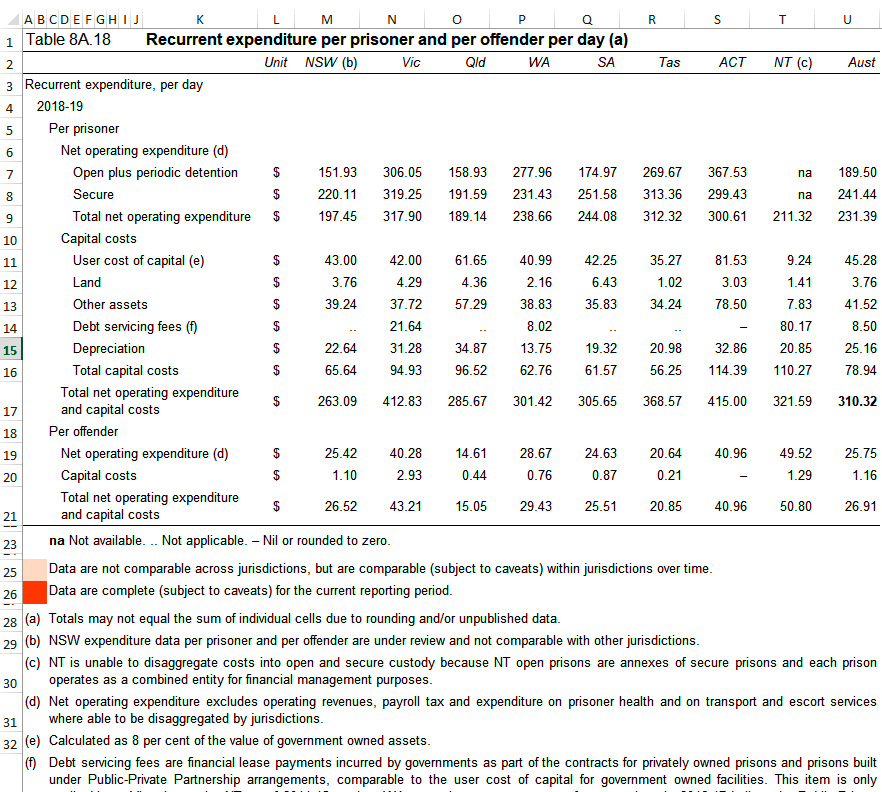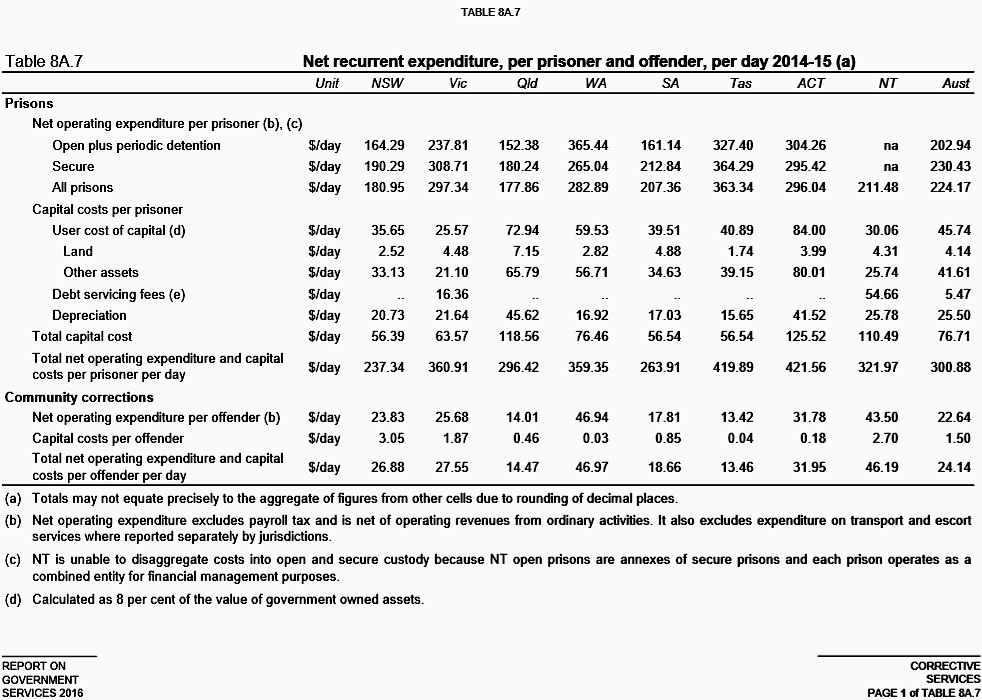Thinking Outside the Cell Defined Terms Baker's Dozen Problems Articles & Reports - Bibliography
Material Public Purse Prison and Prisoner Costs of the Australian Prison System
within Correctional Services or Material Prisoner Costs borne by the Public PurseIn 2018-19 the national imprisonment rate was 219 per 100,000 people in the relevant adult population - an increase of 29.95% since 2008‑09. 43,028 inmates were incarcerated in Australia's state and territory prisons at 30 June 2019. The average burden upon the Public Purse is $302 per day per prisoner
Recidivism among prisoners in Australian gaols is measured by the rate at which released prisoners return to prison.
How much does prison really cost? Comparing the costs of imprisonment with community corrections - Australia Institute of Criminology - Anthony Morgan - 2018
A. Australia spends an estimated $16 billion a year on our Criminal Justice System (police services, courts and Correctional Services).
B. There are now 36,000 inmates in Australia's prisons, up 39 per cent from a decade ago - the prison system costs the Australian taxpayer almost $4 billion annually.
C. Australia's $4 billion annual prison system has created a "class of persistent criminals":
(i) 58 percent of prisoners have been imprisoned before (stable over the past 10 years)
(ii) 44.6 percent of prisoners released during 2013-14 returned to prison within two years (up from 39.5 percent five years ago)
(iii) 52.6 percent of prisoners released during 2013-14 returned to corrective services within two years
In Nov. 2012, the Commonwealth Senate commissioned a Legal and Constitutional Affairs References Committee ("LCARC") to prepare a report on the 'criminal justice system' which costs the Australian taxpayer $16 billion annually and ".... is quickly becoming unsustainable".
Below is an extract from Chapter 3 of the LCARC report titled 'Value of a justice reinvestment approach to criminal justice in Australia' dated June 2013:
3.31 The increase in prisoner numbers is putting financial strain on the Australian justice system, which is quickly becoming unsustainable. Released prisoners are
finding it difficult to find work and are facing multiple barriers to reintegrating with society. In addition, the removal of an individual from a community or family can
have long lasting effects, as well as increasing financial burden. Due to the overcrowding of prisons, prisoner health is deteriorating and those health issues are
being transferred to society with the release of prisoners. Governments need to address the long term economic and social costs of imprisonment to prevent further development of intergenerational offending, and occurrences of recidivism.
Below is an extract from THE COST OF PRISONS IN AUSTRALIA: - July 2023 - Institute of Public Affairs:
The level of government spending on prisons is wasteful and unsustainable
• Australia spends over $6 billion each year on the construction and operation of prisons – this has increased by $2 billion in just five years.
• The cost of incarceration to the taxpayer is $147,900 per prisoner per year, or $405 per day.
• As the number of sentenced prisoners continues to grow, so will government spending on prisons.
• Each year $2.3 billion is spent on imprisoning low-risk non-violent offenders.
• A one per cent shift in the number of non-violent offenders in prison would save the taxpayer more than $23 million per year nationwide.
• The ACT spends the most of all the states on ongoing costs such as staffing and maintenance despite having the lowest percentage of prison utilisation.
Below is an extract from Australia spending more on prisons, policing than other comparable countries: report - ABC News:
The report, by conservative think tank the Institute of Public Affairs (IPA), said despite spending an estimated $16 billion a year on our criminal justice system, Australians felt less safe than the citizens of many comparable countries.
Author Andrew Bushnell said Australia's $4 billion prison system had created a "class of persistent criminals" because it was failing to reform inmates.
The report — Australia's Criminal Justice Costs: An International Comparison — said Australian prisons were the fifth most expensive among 29 countries in the Organisation for Economic Cooperation and Development (OECD).
Sweden, Norway, and the Netherlands made up the top three.
In Australia in 2015, the cost of putting one person behind bars for a year was nearly $110,000. The OECD average was $69,000 per person.
The study found incarceration rates are growing rapidly — there are now 36,000 prisoners in Australia, up 39 per cent from a decade ago.
"Over the past five years, international figures show Australia's incarceration growth has outstripped that of many comparable countries," the report said.
"Fellow common law countries, the United States, the United Kingdom, Canada, Ireland and New Zealand all reduced their incarceration levels over the [same] period."
Below are pertinent extracts from Prison Privatisation in Australia - Accountability, Costs, Performance and Efficiency - Sydney University - 2016:
Australia now imprisons more people than at any point in its history. As of June 2015, 36,134 people were incarcerated across eight states, and the national imprisonment rate stood at 196 prisoners per 100,000 people (ABS, 2015: Table 2). The total annual net cost of Australia’s prison system stands at $3.4 billion (Productivity Commission, 2014: Table 8A.12).
The below Table 8A.8 from Report on Government Services 2020 - Part C, Section 8 'Corrective services' notes that as at 30 June 2019 -
* Total Net Operating and Capital Expenditure Costs had slightly increased (from June 2015 of $300.88) to $310.32 per inmate per day or $113,267 pa; and
* Net Operating Cost per 'Secure' prisoner ranges from $220.11 per day in the NSW up to $313.36 per day in Tas - average across the country of $241.44 per day or $88,125.60.

Annual Administrative Cost of Australian Maximum Security Prisons - $150,000 p.a. per inmate in 2019
Below is an extract from
The Booming Industry continued: Australian Prisons a 2017 update - January 2017 that refers to the afore-mentioned prisoner costs across the various Australian states, but also factors in Capital Expenditure Costs for construction and modification that appear further down the above Table 8A.7 :Costs
Prison is an expensive business with the taxpayer footing the total bill. Both the financial and social costs of locking up more people are, not surprisingly, increasing. Expenditure on prisons alone in Australia in 2014/2015 was $2.9 billion (Productivity Commission 2016: 8.3). From 2007-2008 to 2012-2013, criminal justice (all criminal justice agencies) expenditure increased by 24% overall and by an average of 5% each year (AIC 2014). All jurisdictions are building more prisons or expanding current prisons to accommodate the growing numbers. The costs of building prisons are high but higher still are the recurrent costs of maintaining and running them (NSW Legislative Council Inquiry into the Increase in Prisoner Population 2001; Productivity Commission 2016:8.4). The total average cost (including capital and recurrent costs) per prisoner per day in Australia in 2014-2015 was $301 - $109,865 per NSW prisoner p.a. (Productivity Commission 2016:8.22).
This varied across states and territories and was the highest in -
* the Australian Capital Territory ($421 per prisoner per day) $153665 per ACT prisoner p.a. ; and
* Tasmania ($420 per prisoner per day) $153,300 per ACT prisoner p.a. (Productivity Commission 2016).
In 2016, the NSW Government announced it would spend a further $3.8 billion dollars on the expansion of the prison estate in NSW, in order to increase current prison capacity by 7,000 beds (NSW Government 2016).
Below are extracts from Productivity Commission's report: Chapter 3 - The economic and social costs of imprisonment - part of an Australian Parliamentary Report dated 2013
The committee was provided with details of expenditure in various jurisdictions.
The Western Australian Department of Corrective Services calculated that the cost per day for –
· juvenile detention was $624 per person, and
· juvenile community custody $77 per person.
The cost of detaining a young person was $227,760 per annum.4 - in 2013
Below are extracts from Youth detention population in Australia 2019 - Summary - Bulletin 148 • February 2020 produced by the Australian Institute of Health and Welfare
There were 949 young people in youth detention on an average night in the June quarter 2019. The vast majority (90%) were male. Most detainees (83%) were aged 10–17, a rate of 3.3 per 10,000 young people in this age group. The other detainees were aged 18 or over. Almost 2 in 3 (63%) young people in detention on an average night in the June quarter 2019 were unsentenced—that is, they were awaiting the outcome of their court matter or sentencing. The remainder were serving a sentence.
Just over half (53%) of all young people in detention on an average night in the June quarter 2019 were Aboriginal or Torres Strait Islander. Young Indigenous Australians aged 10–17 were 21 times as likely as young non-Indigenous Australians to be in detention on an average night, and this fluctuated, at 19–26 times the non-Indigenous rate over the 4-year period.
Below are extracts from A NSW for Young People: Beyond 2019 by Youth Action
Keep young people out of prison
In 2016–2017:
· 1,500 young people were being supervised either in the community or in a youth detention centre.1
· 48% of children and young people in custody in NSW were Aboriginal and Torres Strait Islander.2
· Aboriginal and Torres Strait Islander children and young people are 21 times more likely to be detained than non-Indigenous children and young people in NSW.
· 87% of young people in NSW prisons have a mental health condition (including alcohol or drug-related problems).3
· $1,344 is the daily cost of detaining one child or young person in NSW.
· $490,560 is the cost of detaining one child or young person in NSW for one year.
· 66% of young people released from prison reoffend within 12 months.
